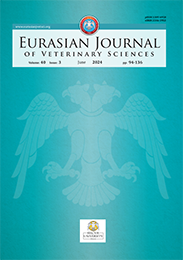| 2014, Cilt 30, Sayı 2, Sayfa(lar) 108-110 |
| [ Türkçe Özet ] [ PDF ] [ Benzer Makaleler ] |
| Vulvo-vaginal myiasis in a queen caused by Lucilia sericata (Diptera: Nematocera: Calliphoridae) |
| Oktay Yilmaz1, Mustafa Kose2 |
| 1Department of Obstetrics and Gynaecology, Afyon Kocatepe University, Afyonkarahisar, Turkey 2Department of Parasitology, Faculty of Veterinary Medicine, Afyon Kocatepe University, Afyonkarahisar, Turkey |
| Keywords: Vulvo-vaginal myiasis, cat, Lucilia sericata |
| Downloaded:2083 - Viewed: 3150 |
|
A 3-year-old shorthair queen was referred to the animal hospital
in July with the complaint of dystocia that started five
days ago. Abdominal ultrasonography revealed that no structures
related to fetus or fetal fuid were evident however, radiography
of pelvic axis showed fetus-related bone opacities.
On vaginal examination, a reddish-brown, fetid and slimy
vaginal discharge and a total of eleven larvae were observed
and the all larvae were transported to Parasitology laboratory.
On exploratory laparotomy, two dead fetuses were
seen throughout the corpus-cervix uteri, therefore ovariohysterectomie
was performed after the approval of the owner.
The morphology of Dipteran fly larvae and the adult flies
which were emerged from larvae fed in insectarium provided
evidence that Lucilia sericata was responsible for the genital
myiasis. It is suggested that vulvo-vaginal myiasis should
take into account by veterinary practitioners following
prolonged dystocia cases, especially occurring in poor environmental
conditions in hot seasons.
|
| [ Türkçe Özet ] [ PDF ] [ Benzer Makaleler ] |





